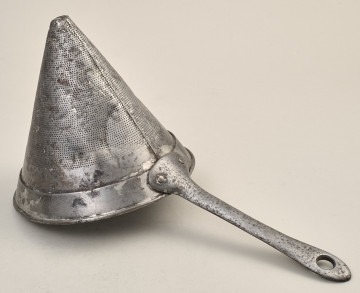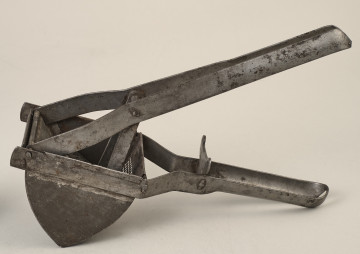
Sieve
19th / 20th century
Castle Museum in Łańcut
Part of the collection: Metale
Sieve (colander) made of tin-plate, it comes from the first half of the 20th century, part of the collection of the Potocki family. A cone-shaped vessel with a handle. The cone (sieve) is made of densely perforated metal sheet, joined by crimping to obtain the appropriate shape, the top is bevelled and sealed. The whole vessel is whitened (tin plated). The vessel in question is exhibited is exhibited in the Eastern Corridor on the second floor, where copper wares (vessels), which are mainly the remains of the no longer existing castle kitchens are gathered. In rich houses, manors and palaces kitchens were richly equipped not only with various kinds of furnaces, ovens (oven for bread, cakes, meat, spits) but also accessories such as pots, pans, saucepans. Kitchen utensils included a wide variety of vessels such as fish trays, saucepans, cauldrons, kettles and moulds for junkets, puddings, cakes (moulds for babas) and jellies, meat cleavers for separating meat, decorated with animal figures or their heads; the most common material used was copper, which is a very good conductor of heat. The handles of such vessels were made of steel (iron), which heated up much more slowly than copper. Due to the formation (as a result of the reaction of copper with carbon dioxide) of verdigris on the surface of such vessels, they were whitened (tin plated) for safety reasons. Still at the beginning of the 20th century, the jams fried in copper saucepans, shaped like a flat pan with a long handle, were widely considered as the most tasteful. Copper vessels were hand made and decorated using the technique of repoussage, i.e. cold hammering. Despite technological developments and the development of new materials, copper cookware is still in use due to its advantages.
Author / creator
Dimensions
height: 18.5 cm, width: 18.8 cm
Object type
Metals
Technique
tin coating
Material
sheet metal
Creation time / dating
Creation / finding place
Owner
Castle Museum in Łańcut
Identification number
Location / status

19th / 20th century
Castle Museum in Łańcut

19th / 20th century
Castle Museum in Łańcut

19th / 20th century
Castle Museum in Łańcut
DISCOVER this TOPIC
Castle Museum in Łańcut
DISCOVER this PATH
Educational path